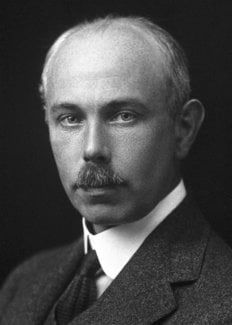Francis W. Aston
Biographical

Francis William Aston was born in September 1877 at Harborne, Birmingham, England, the third of a family of seven children. He was educated at Harborne Vicarage School and Malvern College where his interest in science was aroused. In 1894 he entered Mason College, Birmingham (later to become the University of Birmingham) where he studied chemistry under Frankland and Tilden, and Physics under Poynting. His winning of the Forster Scholarship in 1898 enabled him to work on the optical properties of tartaric acid derivatives; the results of this work were published in 1901.
Leaving academic life for a time, he worked for three years as a chemist in the laboratory of a brewery. At about this time, however, his interest in physics, rather than chemistry, began to predominate; his aptitude for mechanical contrivance showed itself in his design and construction of new types of pumps for evacuating vessels. From this stemmed his interest in gas discharge phenomena in evacuated tubes.
In 1903 he obtained a scholarship to Birmingham University (as it had now become) to work on the properties of the Crookes Dark Space in discharge tubes. Within a short time he had discovered the phenomenon which is known as the Aston Dark Space. At the end of 1909 he accepted the invitation of Sir J.J.Thomson to work as his assistant at the Cavendish Laboratory, Cambridge, on studies of positive rays. It was during this period that he obtained definite evidence for the existence of two isotopes of the inert gas neon.
This research was interrupted by the War of 1914-1918, during which time Aston worked at the Royal Aircraft Establishment, Farnborough, where he studied the effect of atmospheric conditions on aeroplane fabrics and dopes (i.e. synthetic coatings).
Returning to the Cavendish Laboratory in 1919, he again attacked the problem of the separation of the isotopes of neon. He quickly achieved success in this by his invention of the mass spectrograph, an apparatus in which the ingenious use of electromagnetic focusing enabled him to utilize the very slight differences in mass of the two isotopes to effect their separation. Extending this principle to other chemical elements, he discovered, in a series of measurements, no less than 212 of the naturally occurring isotopes. From the results of this work he was able to formulate the so-called Whole Number Rule which states that, the mass of the oxygen isotope being defined, all the other isotopes have masses that are very nearly whole numbers.
Aston continued to make measurements, using an improved instrument, with ever-increasing refinement and precision. He observed and was able to measure those deviations from the Whole Number Rule which were to become so important in the field of atomic energy.
The results of his work were published in the Proceedings of the Royal Society and in the Philosophical Magazine. He was also the author of the books Isotopes (1922; revised edition 1941) and of Structural Units of the Material Universe (1923).
Aston was elected to a Fellowship at Trinity College in 1920, in which year he also received the Mackenzie Davidson Medal of the Röntgen Society. In 1921 he was made a Fellow of the Royal Society and was awarded the Society’s Hughes Medal the following year, the same year that he received the Nobel Prize. The John Scott and the Paterno medals were given to him in 1923, the Royal medal in 1938, and he was Duddell medalist of the Physical Society in 1941.
He was an honorary member of the Russian Academy of Sciences and of the Accademia dei Lincei, and held honorary doctorates of the Universities of Birmingham and Dublin.
Aston, a bachelor, was an enthusiastic sportsman; skiing, rock climbing, tennis and swimming were among the sports in which he excelled. He was also keen musician, playing the piano, violin and the cello.
He died at Cambridge on November 20, 1945.
This autobiography/biography was written at the time of the award and first published in the book series Les Prix Nobel. It was later edited and republished in Nobel Lectures. To cite this document, always state the source as shown above.
Francis W. Aston died on 20 November 1945.
The Nobel Foundation's copyright has expired.Nobel Prizes and laureates
Six prizes were awarded for achievements that have conferred the greatest benefit to humankind. The 14 laureates' work and discoveries range from quantum tunnelling to promoting democratic rights.
See them all presented here.
